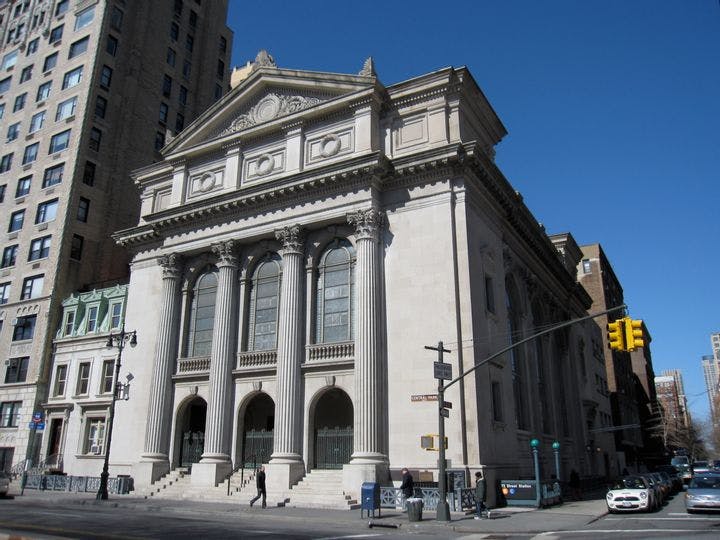Fall 2009
Jews in America
– Amy E. Schwartz
Tracing the history of Judaism in its many forms in America.
There is nothing new under the sun, says the Preacher in the Book of Ecclesiastes. But even the Preacher might have arched an eyebrow at the variety of innovations that crowd under the umbrella name of American Judaism. Freed by modernity from age-old prejudices and restrictions, and mostly emerged now from a generation that focused with near-exclusive intensity on Holocaust remembrance and support for Israel, Jews in America have produced an astonishing array of personal and communal practices. Variants range from Jubus (Jews influenced by Buddhism) to baalei teshuva (those raised secular who return to rigorous observance as adults), plus countless improvisers such as the fellow Ari Goldman described several years ago in his book Being Jewish, who observed the laws about avoiding leavened bread during Passover by taking a piece of matzah to baseball games and substituting it for the bun around his nonkosher hot dog.
Dana Evan Kaplan, a rabbi in the Reform movement, the leftmost of the three major Jewish denominations, sees broad, unifying themes in this churning disorder. American Jews, he says, internalized the country’s cultural values during the 20th century. Now, as the traditional denominations and synagogue communal structures fade, those values have powered the revival of Jewish identity and practice among America’s roughly six million Jews through distinctively American quests for individual spiritual fulfillment.
This is not a new idea, but Kaplan’s survey of the landscape is enhanced by some unexpected examples. He traces the influence of basic civic values such as choice and individualism, particular political values such as feminism and environmentalism, and subtler Christian cultural inflections such as a preference for a publicly proclaimed spirituality—“peak moments,” often in public, of accepting God in the heart—over the traditional Jewish spirituality arising from adherence to commandments and membership in the community. This preference for moments of public commitment, he suggests, helps account for the increased prominence of life cycle milestones such as the bar mitzvah.
Kaplan’s gallery of American-inflected Jewish innovators is entertaining and mostly illuminating, though his sympathy for some of the wackier ones may outdistance the reader’s. There are “adventure rabbis” who seek to give their congregants Jewish spiritual experiences through hiking and kayaking expeditions, “aboriginal” Jews striving to incorporate Native American practices, “God-is-a-verb” mystics who link Jewish faith to social activism, and Web surfing Lubavitcher Hasidim whose 18th-century worldview has proved surprisingly compatible with high-tech outreach techniques. (These include the Mitzvah Mobile, which cruises city streets seeking Jews who might like to fulfill a mitzvah, or commandment, and innumerable Web sites offering practical information on ritual requirements.)
Kaplan ascribes to egalitarianism and individualism some developments not hitherto seen as especially spiritual—for instance, the Reform movement’s controversial 1983 decision to count children of a Jewish father and a non-Jewish mother as Jewish if they are being raised Jewish. (Traditionally, only children of a Jewish mother have been recognized as Jews, a position still upheld by most denominations.) The same sense of spiritual autonomy put tremendous pressure on clergy to solemnize intermarriages. Couples “felt they had a right to make whatever personal decisions they wanted,” Kaplan writes, “and they expected the clergy to validate their choices without hesitation.”
He characterizes the patrilineal descent decision as “widely seen as a tremendous success,” reflecting his tilt toward the viewpoint of his own Reform movement—perhaps the likeliest to engage in the kind of values syncretism he describes. In discussing the frantic efforts of traditional synagogues to regain some traction in the religious marketplace, he shows a weakness for management jargon, for congregational re-visioning exercises and retreats and curriculum development initiatives. Just often enough, though, Kaplan emerges from the bureaucratic/theological thicket with a twinkle in his eye. Most American families, he admits, still look for three things in a synagogue: “a quality preschool, a caring rabbi, and a short commute.”
As for the wails of impending catastrophe that inevitably accompany evolutions in Jewish practice, Kaplan contributes his share—he is a rabbi, after all—but with a refreshing air of restraint. In 1964, he reports, “the original Look magazine published a cover story . . . on ‘The Vanishing American Jew.’ The magazine cited what was to become the usual litany of sociological problems: Jews were not particularly devout, increasing numbers were intermarrying, fertility rates were low.” Though he calls the passage “eerily clairvoyant,” Kaplan concedes that there is another side: “Cynics would later point out that Look magazine itself disappeared not once but twice, while the Jews remained.”
* * *
Amy E. Schwartz is a contributing editor of The Wilson Quarterly.
Reviewed: "Contemporary American Judaism: Transformation and Renewal" by Dana Evan Kaplan, Columbia University Press, 2009.
Photo courtesy of Wikimedia Commons
